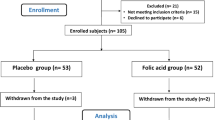Abstract
Aims: To assess plasma concentrations of folic acid, vitamin B12, and total plasma homocysteine (tHCY) during fasting and after methionine load in young patients with Type 1 diabetes mellitus (T1DM). Methods: We enrolled 41 young patients with T1DM without any sign of microvascular complications and 123 healthy controls in a 1:3 case-control study. Fasting and post-methionine load (PML) tHCY, folic acid, and vitamin B12 levels were measured in both groups. Data regarding chronological age, metabolic control (assessed by mean values of glycated hemoglobin in the last 12 months) and disease duration were also recorded. Results: Fasting and PML tHCY levels were significantly lower in patients than in controls: 7.3±2.7 μmol/l vs 8.3±2.5 μmol/l (p=0.01), and 16.7±5.8 μmol/l vs 17.3±4.3 μmol/l (p=0.01), respectively. No correlation was found between fasting and PML tHCY levels and chronological age, disease duration, metabolic control, and insulin requirement. Patients had significantly higher vitamin B12 levels compared to controls: 767±318 pg/ml vs 628±236 pg/ml (p=0.003), while folic acid turned out to be lower in patients than in controls: 5.3±1.9 nmol/l vs 7.5±2.6 nmol/l (p<0.0001). Conclusions: Adolescents and young adults with T1DM without microvascular complications showed lower tHCY both during fasting and after methionine load. Lower folate concentrations in these patients might benefit from food fortification.
Similar content being viewed by others
References
Selhub J. Homocysteine metabolism. Annu Rev Nutr 1999, 19: 217–46.
Graham IM, Daly LE, Refsum HM, et al. Plasma homocysteine as a risk factor for vascular disease. The European Concerted Action Project. JAMA 1997, 277: 1775–81.
Selhub J. Public health significance of elevated homocysteine. Food Nutr Bull 2008, 29 (Suppl 2): S116–25.
Morrish NJ, Wang SL, Stevens LK, Fuller JH, Keen H. Mortality and causes of death in the WHO Multinational Study of Vascular Disease in Diabetes. Diabetologia 2001, 44 (Suppl 2): S14–21.
Hofmann MA, Kohl B, Zumbach MS, et al. Hyperhomocyst(e)inemia and endothelial dysfunction in IDDM. Diabetes Care 1997, 20: 1880–6.
CroninCC, McPartlin JM, Barry DG, Ferriss JB, Scott JM, Weir DG. Plasma homocysteine concentrations in patients with type 1 diabetes. Diabetes Care 1998, 21: 1843–7.
Pavía C, Ferrer I, Valls C, Artuch R, Colomé C, Vilaseca MA. Total homocysteine in patients with type 1 diabetes. Diabetes Care 2000, 23: 84–7.
Wiltshire E, Thomas DW, Baghurst P, Couper J. Reduced total plasma homocyst(e)ine in children and adolescents with type 1 diabetes. J Pediatr 2001, 138: 888–93.
Salardi S, Cacciari E, Sassi S, et al. Homocysteinemia, serum folate and vitamin B12 in very young patients with diabetes mellitus type 1. J Pediatr Endocrinol Metab 2000, 13: 1621–7.
Cotellessa M, Minniti G, Cerone R, Prigione F, Calevo MG, Lorini R. Low total plasma homocysteine concentrations in patients with type 1 diabetes. Diabetes Care 2001, 24: 969–71.
The Expert Committee on the Diagnosis and Classification of Diabetes Mellitus. Report of the Expert Committee on the Diagnosis and Classification of Diabetes Mellitus. Diabetes Care 1997, 20 (Suppl 1): 1183–97.
Minniti G, Cerone R, Piana A, Armani U, Lorini R. Plasma and serum total homocysteine concentrations in paediatric patients, evaluated by high-performance liquid chromatography with fluorescence. Clin Chem Lab Med 2000, 38: 675–6.
Hoey L, McNulty H, Askin N, et al. Effect of a voluntary food fortification policy on folate, related B vitamin status, and homocysteine in healthy adults. Am J Clin Nutr 2007, 86: 1405–13.
Jacques PF, Selhub J, Bostom AG, Wilson PW, Rosenberg IH. The effect of folic acid fortification on plasma folate and total homocysteine concentrations. N Engl J Med 1999, 340: 1449–54.
Chiarelli F, Pomilio M, Mohn A et al. Homocysteine levels during fasting and after methionine loading in adolescents with diabetic retinopathy and nephropathy. J Pediatr 2000, 137: 386–92.
Veldman BA, Vervoort G, Blom H, Smits P. Reduced plasma total homocysteine concentrations in Type 1 diabetes mellitus is determined by increased renal clearance. Diabet Med 2005, 22: 301–5.
Matteucci E, Rossi L, Mariani S et al. Blood levels of total homocysteine in patients with type 1 diabetes (with no complications, diabetic nephropathy and/or retinopathy) and in their non-diabetic relatives. Nutr Metab Cardiovasc Dis 2002, 12: 184–9.
Wollesen F, Brattström L, Refsum H, Ueland PM, Berglund L, Berne C. Plasma total homocysteine and cysteine in relation to glomerular filtration rate in diabetes mellitus. Kidney Int 1999, 55: 1028–35.
Smulders YM, Rakic M, Slaats EH, et al. Fasting and post-methionine homocysteine levels in NIDDM. Determinants and correlations with retinopathy, albuminuria, and cardiovascular disease. Diabetes Care 1999, 22: 125–32.
Wotherspoon F, Laight DW, Browne DL, et al. Plasma homocysteine, oxidative stress and endothelial function in patients with Type 1 diabetes mellitus and microalbuminuria. Diabet Med 2006, 23: 1350–6.
Cerone R, Minniti G, Piana A, Armani U, Lorini R. Mild hyperhomocysteinemia: vitamin supplementation or not? Am J Clin Nutr 2001, 74: 271–2.
Boushey CJ, Beresford SA, Omenn GS, Motulsky AG. A quantitative assessment of plasma homocysteine as a risk factor for vascular disease. Probable benefits of increasing folic acid intakes. JAMA 1995, 274: 1049–57.
Wotherspoon F, Laight DW, Turner C, et al. The effect of oral folic acid upon plasma homocysteine, endothelial function and oxidative stress in patients with type 1 diabetes and microalbuminuria. Int J Clin Pract 2008, 62: 569–74.
Author information
Authors and Affiliations
Corresponding author
Rights and permissions
About this article
Cite this article
Giannattasio, A., Calevo, M.G., Minniti, G. et al. Folic acid, vitamin B12, and homocysteine levels during fasting and after methionine load in patients with Type 1 diabetes mellitus. J Endocrinol Invest 33, 297–299 (2010). https://doi.org/10.1007/BF03346589
Published:
Issue Date:
DOI: https://doi.org/10.1007/BF03346589




